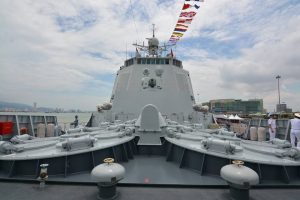At any given moment there is likely a continuous patrol of People’s Liberation Army Navy (PLAN) surface and subsurface vessels within the East and South China Seas. These ships maintain a near constant presence in these areas, where China lays claim to contested territorial features such as the Senkaku, Paracel, and Spratly Islands.
The Renhai-class (Type 055) cruiser is the newest addition to the PLAN, with the first hull commissioned in January of this year. Four more are on the docket to be ready by the end of the 2020s. Once these are deployed and patrolling with the rest of the Chinese naval inventory, the balance of force projection will shift in these highly disputed waters. This cruiser will be the linchpin in the Chinese strategy of anti-access and area denial (A2/AD), which they continuously employ within the entirety of the nine-dash line and within the first island chain. It will also be the ship to beat for everyone else asserting their power against the PLAN.
The Renhai brings strategic air defense, anti-surface, and subsurface capability that has the potential to surpass its predecessors like the Luyang-class destroyers. It far outpaces surface combatants of a similar class possessed by any of China’s neighbors, particularly the South Korean Sejong-class destroyer and Japanese Atago-class destroyer.
The Renhai will facilitate improvements in China’s surface warfare capabilities in three key ways. Improved anti-air capability will be capitalized on by using the HHQ-9, which is also in use by the Luyang class. Increased anti-surface capability will be seen with the YJ-18 anti-ship cruise missile (ASCM) and CJ-10 land attack cruise missile (LACM). Finally and most importantly, the potential to have a ship-borne anti-ship ballistic missile with ground-breaking ranges will be what distinguishes the Renhai from any other surface vessel.
For A2/AD to be successful, it is necessary to incorporate mutually supportive strategic surface-to-air missile defense. The HHQ-9, the naval variant in this family of surface-to-air missile systems, can engage air assets at 300-plus kilometers. Although the Luyang-class destroyers have the same weapon system for aerial defense, the Renhai has up to 128 vertical launch system (VLS) silos while the Luyang class has only 64. Additionally, these VLS silos are multirole and hold not only anti-air missiles but also ASCMs and LACMs.
In a South China Sea A2/AD scenario, four forward-deployed Renhai-class destroyers will be able to control the air traffic from the Luzon Strait to the western side of Taiwan. If they were to be deployed in strike groups, comparable to how the United States employs its Navy, they would be accompanied by an aircraft carrier such as the Liaoning. By 2030 China is expected to have three more carriers, which would complement the Renhai’s ability to carry out a pivotal A2/AD role. This would put the formidable HHQ-9 into play alongside J-15 air-to-air fighters, complicating a solution to the A2/AD problem set for any potential adversary.
Particularly concerning is the firepower the CJ-10 LACM provides. The assessed range of 1,500 kilometers would mean stand-off strike capability for a Taiwan seizure scenario or even the potential to strike anywhere within the first island chain where adversarial forces could be setting up expeditionary basing operations. Concurrently protecting the strike group with the supersonic YJ-18 ASCM at ranges up to 540 kilometers would provide the capability to strike shore-based coastal defense missile sites. Airfields, destroyers, and other surface combatants well outside of the first island chain would simultaneously also be vulnerable.
China will invariably have the biggest stick in the pond by 2030 unless the United States’ acquisition programs are making calculated efforts to counter these capabilities. Though it is partially a force projection issue versus a technological gap when compared to the Arleigh Burke-class destroyer, the balance will be tipped in Beijing’s favor, which could increase the potential for a calculated first strike instability problem within the first island chain. China will have the opportunity to expand its list of potential targets as they undermine Beijing’s political goals in the South China Sea. With several of nations laying claim to the territory, the Renhai cruiser should precipitate counterdevelopments by nations with a vested interest in freedom of navigation through these seas.
Zachary Williams is an officer in the U.S. Marine Corps. He is also an MBA Student at the University of Maryland Global Campus. Follow him on LinkedIn. The views expressed here are his own and do not represent the views of the U.S. Marine Corps or the U.S. government.

































